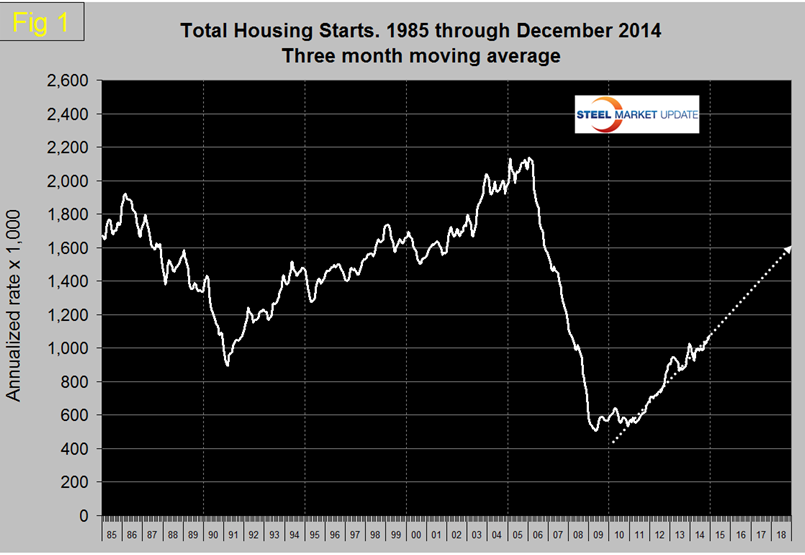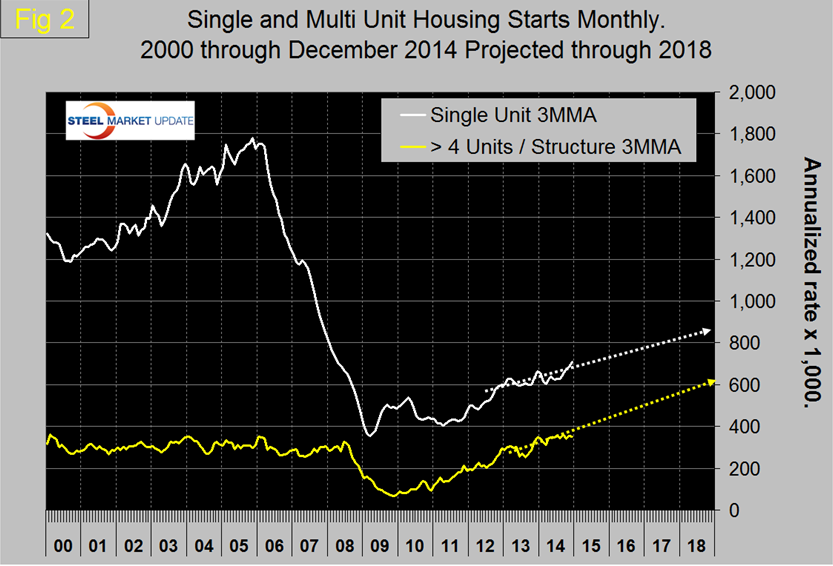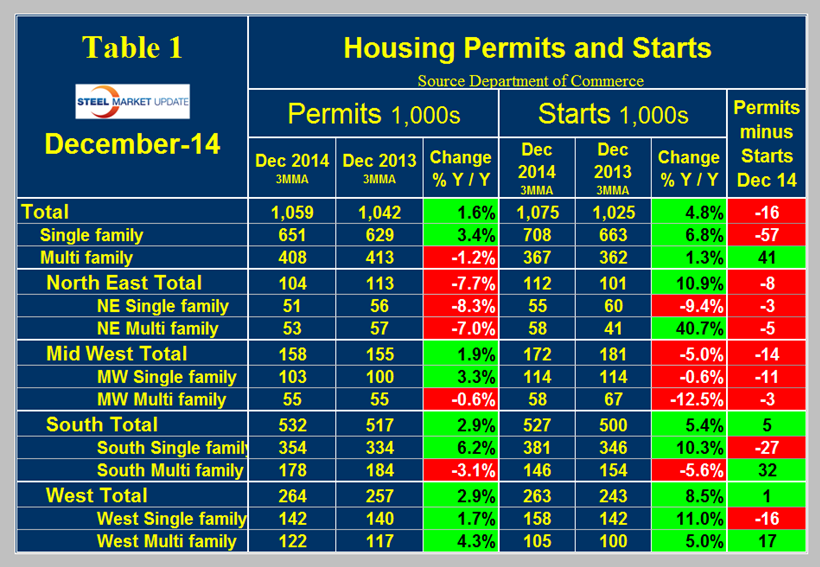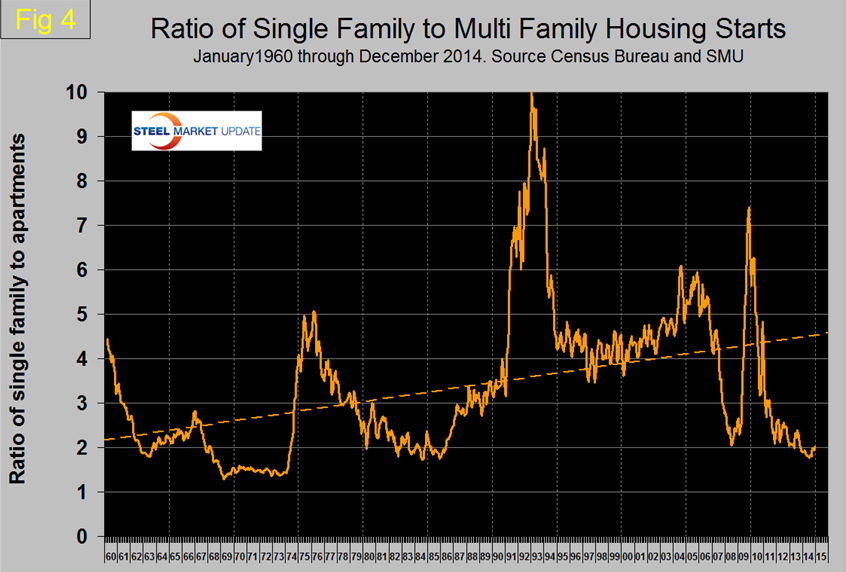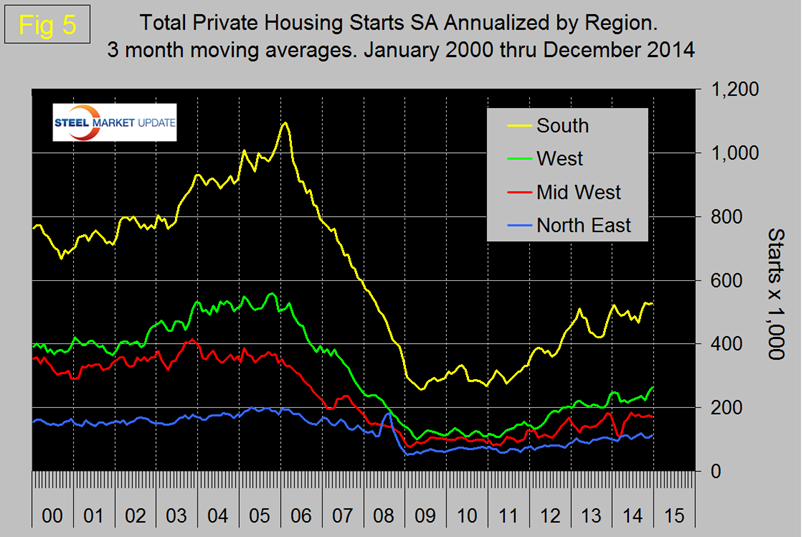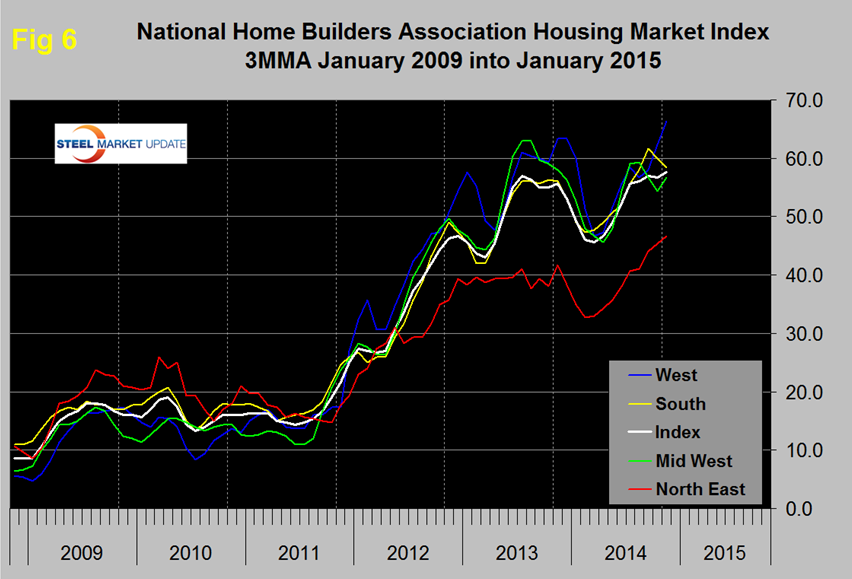Analysis

January 22, 2015
Housing Starts 3MMA Exceed 1 Million Units for 4th Month
Written by Peter Wright
Starts in December rose to an annual rate 1,089,000 from 1,043,000 in November. The three month moving average, (3MMA) rose to 1,075,000, (Figure 1). This was the fourth consecutive month that the 3MMA of starts exceeded a million units. The year / year growth rate of the 3MMA of total starts in December was 4.8 percent. The growth rate by this measure is down sharply from 16.7 percent in September. Note this is not seasonal as we are considering year over year relationships. Total starts are still on track to reach 1.6 million by the end of 2018.
Multifamily starts are now beyond the prerecession high of January 2006 but single family are still 60.1 percent below the level enjoyed at that time, (Figure 2).
The decline in the growth rate of total starts is entirely reflective of the multifamily sector the growth of which has declined from 35.9 percent in August to 0.6 percent in December, 3MMA year over year. Single family growth by the same measure has ranged erratically between 4.0 percent and 12.1 percent, (Figure 3).
Permit data is useful to evaluate where future starts are headed. If permits exceed starts then we anticipate an acceleration and vice versa. Table 1 shows that total permits were 16,000 less than starts in December on a 3MMA basis.
However the situation continues to be dramatically different for single and multi-family units. Single family permits were 57,000 less than starts and multi-family permits were 41,000 more than starts. This signals that the recent decline in multifamily starts is likely to be short lived and that the improvement in single family doesn’t have legs. The ratio of the two sectors is shown in Figure 4 and demonstrates that single family compared to multifamily has improved slightly but single family homes continue to be less desirable than at any time in the last 30 years. Based on permit data this trend will not change any time soon. Student loan debt exceeded $1.3 trillion in the 3rd Q of 2014 for the first time, this must be impacting the young person’s view of other debt obligations and so presumably is the view that housing is not necessarily the great investment that it was once thought to be. In addition uncertainty in the job market makes mobility desirable and promotes the idea of rent in preference to purchase. To attempt to counter these trends Fannie Mae and Freddie Mac have introduced a new program for first time buyers that require only a 3 percent down payment down from what has become the traditional 20 percent level since the subprime debacle. First time buyers normally account for 40 percent of new home sales. In this case first time is defined as not having held a mortgage for three years.
The situation in the four regions reported in the Census Bureau report was not synchronous in December. Total starts improved in all areas except the Mid-West. Single family starts improved in the South and West and declined in the Northeast and Midwest. The Northeast had the worst permit performance in three months through December. The Midwest and South both had a year over year decline in multifamily permits. Figure 5 shows the regional situation for total residential starts since January 2000.
The National Association of Home Builders, (NAHB) confidence report was released on Tuesday, (Figure 6). Any value above 50 indicates an overall positive business confidence. The index declined by one point to 57 in January and the 3MMA increased one point to 57.7 which is the highest value since our data stream begins in January 2009. The composite index, signals that homebuilders are generally positive in their views of the market.
The following is a report from the National Association of Home Builders
January 20, 2015 – Builder confidence in the market for newly-built single-family homes declined one point to 57, according to the latest National Association of Home Builders/Wells Fargo Housing Market Index released today. This marks the third straight month that the index has hovered in the upper 50s range.
“After seven months above the key 50 benchmark, builder sentiment is reflecting the gradual improvement that is occurring in many markets throughout the nation,” said NAHB Chairman Kevin Kelly, a home builder and developer from Wilmington, Del.
“January’s HMI reading is in line with our forecast as we head into the New Year,” said NAHB Chief Economist David Crowe. “Steady economic growth, rising consumer confidence and a growing labor market will help the housing market continue to move forward in 2015.”
Derived from a monthly survey that NAHB has been conducting for 30 years, the NAHB/Wells Fargo Housing Market Index gauges builder perceptions of current single-family home sales and sales expectations for the next six months as “good,” “fair” or “poor.” The survey also asks builders to rate traffic of prospective buyers as “high to very high,” “average” or “low to very low.” Scores from each component are then used to calculate a seasonally adjusted index where any number over 50 indicates that more builders view conditions as good than poor.
The HMI component gauging current sales conditions remained unchanged at 62 in January while the index measuring expectations for future sales dropped four points to 60 and the component gauging traffic of prospective buyers fell two points to 44.
Looking at the three-month moving averages for regional HMI scores, the West rose by four points to 66, the Midwest registered a three-point gain to 57 and the Northeast was up two points to 47. The South dropped two points to 58.
Editor’s Note: The NAHB/Wells Fargo Housing Market Index is strictly the product of NAHB Economics, and is not seen or influenced by any outside party prior to being released to the public.



